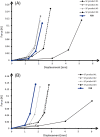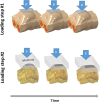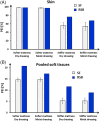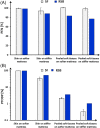The biomechanical efficacy of a dressing with a soft cellulose fluff core in prophylactic use
- PMID: 32869507
- PMCID: PMC7948878
- DOI: 10.1111/iwj.13489
The biomechanical efficacy of a dressing with a soft cellulose fluff core in prophylactic use
Abstract
In this work, we developed an experimental-computational analysis framework which facilitated objective, quantitative, standardised, methodological, and systematic comparisons between the biomechanical efficacies of two fundamentally different dressing technologies for pressure ulcer prevention: A dressing technology based on cellulose fibres used as the core matrix was evaluated vs the conventional silicone-foam dressing design concept, which was represented by multiple products which belong in this category. Using an anatomically-realistic computer (finite element) model of a supine female patient to whom the different sacral dressings have been applied virtually, we quantitatively evaluated the efficacy of the different dressings by means of a set of 3 biomechanical indices: The protective efficacy index, the protective endurance, and the prophylactic trade-off design parameter. Prior rigorous experimental measurements of the physical and mechanical behaviours and properties of each tested dressing, including tensile, compressive, and friction properties, have been conducted and used as inputs for the computer modelling. Each dressing was evaluated for its tissue protection performances at a new (from the package) state, as well as after exposure to moisture conditions simulating wet bedsheets. Our results demonstrated that the dressing with the fluff core is at least as-good as silicone-foams but importantly, provides the best balance between protective performances at its "new" condition and the performance after being exposed to moisture. We conclude that preventative dressings are not equal in their prophylactic performances, but rather, the base technology, the ingredients, and their arrangement in the dressing structure shape the quality of the delivered tissue protection.
Keywords: finite element model; moisture; pressure injury; pressure ulcer; prevention.
© 2020 Medicalhelplines.com Inc (3M) and John Wiley & Sons Ltd.
Figures








Similar articles
-
Pressure ulcer prevention dressing design and biomechanical efficacy.J Wound Care. 2020 Dec 1;29(Sup12):S6-S15. doi: 10.12968/jowc.2020.29.Sup12.S6. J Wound Care. 2020. PMID: 33320759
-
The biomechanical protective effects of a treatment dressing on the soft tissues surrounding a non-offloaded sacral pressure ulcer.Int Wound J. 2019 Jun;16(3):684-695. doi: 10.1111/iwj.13082. Epub 2019 Jan 29. Int Wound J. 2019. PMID: 30697945 Free PMC article.
-
The contribution of a directional preference of stiffness to the efficacy of prophylactic sacral dressings in protecting healthy and diabetic tissues from pressure injury: computational modelling studies.Int Wound J. 2017 Dec;14(6):1370-1377. doi: 10.1111/iwj.12821. Epub 2017 Sep 27. Int Wound J. 2017. PMID: 28960851 Free PMC article.
-
Computer Modeling of Prophylactic Dressings: An Indispensable Guide for Healthcare Professionals.Adv Skin Wound Care. 2019 Jul;32(7S Suppl 1):S4-S13. doi: 10.1097/01.ASW.0000558695.68304.41. Adv Skin Wound Care. 2019. PMID: 31219896 Review.
-
Effectiveness of prophylactic sacral protective dressings to prevent pressure injury: A systematic review and meta-analysis.Int J Nurs Stud. 2019 Dec;100:103400. doi: 10.1016/j.ijnurstu.2019.103400. Epub 2019 Aug 20. Int J Nurs Stud. 2019. PMID: 31629209
Cited by
-
The biomechanical efficacy of a hydrogel-based dressing in preventing facial medical device-related pressure ulcers.Int Wound J. 2022 Aug;19(5):1051-1063. doi: 10.1111/iwj.13701. Epub 2021 Oct 8. Int Wound J. 2022. PMID: 34623741 Free PMC article.
-
Fluid handling by foam wound dressings: From engineering theory to advanced laboratory performance evaluations.Int Wound J. 2024 Feb;21(2):e14674. doi: 10.1111/iwj.14674. Int Wound J. 2024. PMID: 38353372 Free PMC article. Review.
-
The biomechanical efficacy of a dressing with a soft cellulose fluff core in protecting prone surgical patients from chest injuries on the operating table.Int Wound J. 2022 Nov;19(7):1786-1796. doi: 10.1111/iwj.13783. Epub 2022 Mar 4. Int Wound J. 2022. PMID: 35243764 Free PMC article.
-
Evaluation of facial tissue stresses under medical devices post application of a cyanoacrylate liquid skin protectant: An integrated experimental-computational study.Int Wound J. 2022 Mar;19(3):615-632. doi: 10.1111/iwj.13660. Epub 2021 Aug 17. Int Wound J. 2022. PMID: 34402167 Free PMC article.
-
Alternatives and preferences for materials in use for pressure ulcer prevention: An experiment-reinforced literature review.Int Wound J. 2022 Nov;19(7):1797-1809. doi: 10.1111/iwj.13784. Epub 2022 Mar 10. Int Wound J. 2022. PMID: 35274443 Free PMC article.
References
-
- Gefen A, Brienza D, Edsberg L, Milton W, Murphy C, Oomens CWJ, Perry L, Sari Y. The etiology of pressure injuries. In: Prevention and Treatment of Pressure Ulcers/Injuries: Clinical Practice Guideline European Pressure Ulcer Advisory Panel (EPUAP), National Pressure Injury Advisory Panel (NPIAP) and the Pan Pacific Pressure Injury Alliance (PPPIA), 3rd Ed; 2019.
-
- Gefen A, Alves P, Ciprandi G, et al. Device‐related pressure ulcers: SECURE prevention. J Wound Care. 2020;29(Sup2a):S1‐S52. - PubMed
-
- Fulbrook P, Mbuzi V, Miles S. Effectiveness of prophylactic sacral protective dressings to prevent pressure injury: a systematic review and meta‐analysis. Int J Nurs Stud. 2019;100:103400. - PubMed
-
- Hahnel E, El Genedy M, Tomova‐Simitchieva T, et al. The effectiveness of two silicone dressings for sacral and heel pressure ulcer prevention compared with no dressings in high‐risk intensive care unit patients: a randomized controlled parallel‐group trial published online ahead of print. Br J Dermatol. 2020;183:256‐264. 10.1111/bjd.18621. - DOI - PubMed
MeSH terms
Substances
LinkOut - more resources
Full Text Sources
Medical

